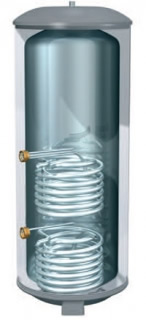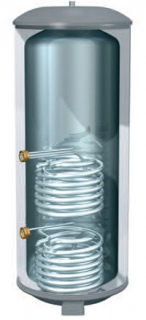
DIRECT CYLINDER
A Direct Cylinder is heated by a source located within the cylinder – such as an electrical immersion heater. Because the Immersion Heater is heating the water ‘directly’ the cylinder is called a ‘Direct Cylinder’. In a direct cylinder there are no other external heat sources.
INDIRECT CYLINDER
 Although heat is imparted to the cylinder by an internal heat exchanger, the heat source is actually remote – such as a gas boiler, solar panel, wood burning stove, Aga etc. etc.. It is therefore deemed that such a cylinder is ‘Indirect’. Indirect cylinders may be fitted with immersion heaters as a supplementary heat source, but they are still known as ‘Indirect’.
Although heat is imparted to the cylinder by an internal heat exchanger, the heat source is actually remote – such as a gas boiler, solar panel, wood burning stove, Aga etc. etc.. It is therefore deemed that such a cylinder is ‘Indirect’. Indirect cylinders may be fitted with immersion heaters as a supplementary heat source, but they are still known as ‘Indirect’.
COMBINATION CYLINDERS
A gravity-fed household copper cylinder is supplied typically from a tank sited above the cylinder – often located in the loft. The higher above the cylinder, the greater the ‘head’ of water and hence the higher the gravity pressure. Where the property is unable to accommodate a header tank (for example in an apartment or flat) the header can be accommodated literally on top of the cylinder and is built into the unit. The cylinder therefore combines the ‘header’ and the ‘storage’ elements and becomes a COMBINATION cylinder.
ECONOMY 7 & ECONOMY 10 Cylinders
An Economy 7 &10 cylinder system is designed to exploit ‘off-peak’ electricity – typically available throughout the night. Because you are heating your cylinder overnight it is important to not to loose the stored heat. Economy 7 cylinders are therefore fitted with an extra thick jacket of insulation – typically 60mm thick, as opposed to the 30mm jacket on a standard cylinder.